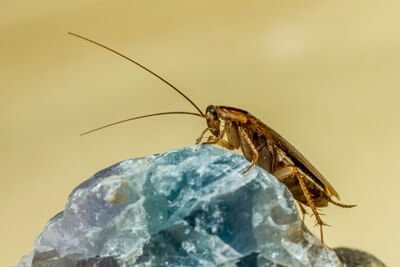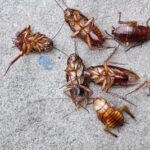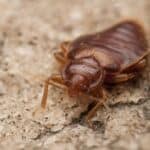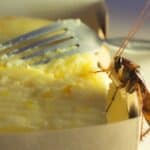Cockroaches are known for eating any food they come across. That requires a mouth and teeth, or so you’d assume. Because cockroaches are insects, they have developed a clever substitute for their mouths. They eat all kinds of decay, wood, and even plastic, so a normal set of teeth wouldn’t suffice.
Roaches don’t have teeth, but they do have a complex structure used for chewing and biting. These are separated into three unique parts. The gizzard contains plates that grind the food in the stomach. The maxilla, located in the front of the roach, chews food so that it can be swallowed. The mandibles bite the food and pull it into the mouth.
Because of this structure, roaches do not grow teeth as they age. They leverage these ‘teeth’ to eat through hard and soft surfaces alike. In fact, it can help them consume food even faster than normal. Roaches can bite humans using their mandibles. Their bite isn’t venomous, but a bite from a roach can become itchy or cause infection if left untreated.
How Many Teeth Do Roaches Have?
Cockroaches have several ‘teeth.’ They just don’t take the form that you’d expect. As mentioned, there are three sets of teeth-like body parts. On the front of its face, the roach has:
- One pair of mandibles
- One pair of maxillae
Inside the gizzard, however, a roach has:
- Six plates
They use this unique physiology to tear, chew, and digest food. This design to their body is what makes them such accomplished pests and decomposers.
Do Cockroaches Have Mouths?
Cockroaches have mouths that allow them to consume food. As unlucky tenants and homeowners can attest, roaches do eat just about anything, from trash to paper to even soap. With that said, most cockroaches prefer to eat soft things. These often include fruits and meat.
In the wild, roaches often have a wide array of food to choose from. This is often in the form of decaying vegetation. Rotting grass and wood are a feast for outdoor roaches. Decaying vegetation is not only abundant and easy to find, but it’s also easy to chew.
Cockroaches developed a unique mouth to suit their lifestyle. The anatomy is similar to that of other insects. It is located on the underside of the head. There are four major parts to the roach’s mouth, including:
Labrum And Labium
The labrum refers to a flattened cuticle in the shape of the flap, which is on the front of the roach’s mouth. Technically speaking, it is located on top of the mouth, or the first layer of the mouth. If compared to human anatomy, the labrum is the upper lip.
The main function of the labrum is to bring food towards the inside of the mouth. After all, roaches don’t have hands. Additionally, the labrum is used to hold the food in position. It stops the food from moving forward so that the roach can continue chewing.
The counterpart of the labrum is the labium. This can be considered the lower lip of the roach. The labium’s main role is to stop the food from spilling out of the mouth.
Mandibles
Perhaps the most iconic part of insect anatomy is the mandibles. Mandibles are usually located on the front of the insect, serving as the jaws. For cockroaches, a pair of mandibles will function as their teeth. They are used to either bite or chew food. While they may seem small, these mandibles can pack a punch.
For insects that bite, the mandibles are often the strongest mouthpart. According to PLOS One, the American cockroach can deliver a powerful bite as well. In fact, researchers have determined that the American cockroach can bite with force similar to ground beetles.
Ground beetles are carnivorous and have specialized their anatomy and behavior to have powerful bites. If that doesn’t sound impressive to you, this bite force translates to about 5 times the bite of a human.
Maxillae
Other than mandibles, the maxillae can also be considered the teeth of cockroaches. The maxilla are pincers that are located just below the mandibles. They are smaller and considered secondary chewing parts. In other words, they support other organs that chew the roach’s food.
Aside from chewing food, maxillae are also responsible for grinding down food into smaller pieces. This allows the food to fit into the digestive tract and into the stomach. There, it can be further broken down and digested.
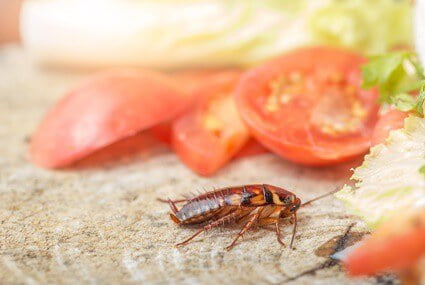
Do Cockroaches Have Teeth In Their Stomach?
Cockroaches do have teeth in their stomach. Technically, these teeth are part of the roach’s digestive tract, in an organ called the gizzard. The gizzard is present in many different species, including insects and birds.
This organ is responsible for breaking down food into smaller pieces. According to the International Journal of Scientific and Research Publications, bacteria in the roach’s gut break down the food further.
The gizzard is often present in omnivorous animals, especially those without teeth in the traditional sense. Omnivorous animals need to adapt to a wider range of food. For example, roaches can eat hard objects, like wood, and soft objects, like grass.
A roach’s mandibles are powerful, but as a whole, the anatomy of a roach doesn’t lend itself to chewing. This results in food that is often swallowed in large chunks, especially harder foodstuffs, like wood.
Do Cockroaches Chew Quickly?
Stomach teeth make them even more invasive pests. Roaches are more likely to seek out softer food, such as kitchen food or, in the wild, rotting debris.
A gizzard, even on soft foods, lets roaches eat food without needing to chew it properly. Instead, these huge chunks go directly down the digestive tract and into the gizzard. There, it is further broken down by the teeth within the organ. This allows roaches to eat at a fast rate.
What Do Stomach Teeth Look Like?
In roaches, stomach teeth come in the form of plates or small discs attached to the walls of the gizzard. These plates are made up of chitin, which is the same material that makes up the roach’s exoskeleton. The gizzard moves during digestion, which basically chews the food stored inside of it.
Do Baby Roaches Grow Teeth?
Roaches don’t grow teeth. Since cockroaches don’t have individual teeth, they don’t create more as they age. In fact, most of a cockroach is fully formed as soon as it hatches. It will molt several times to gain size, speed, and strength. However, no new body parts manifest as it ages. A baby cockroach is just as capable of biting as an adult.
Do Cockroaches Have Fangs?
If you’ve seen a cockroach up close, you might’ve confused its mandibles for fangs. After all, these body parts look like small tusks protruding from its face. Depending on the angle, they may also have resembled a snake’s fangs.
However, mandibles are not fangs and don’t work like them. Roaches are not venomous, so they don’t need fangs to inject poison. That doesn’t mean they’re unwilling to sink those mandibles into your skin, though.
Do Cockroaches Bite?
Cockroaches can use their mandibles to bite. This bite will be rather painful but isn’t toxic or venomous. As such, you won’t feel a dangerous burn for a long time afterward, like with some insects. Instead, the main danger is the bacteria found on cockroaches.
Why Cockroaches Don’t Often Bite
Nonetheless, it’s rare for humans to get bitten by cockroaches. That’s because of:
Fight or Flight
Roaches aren’t aggressive. When confronted by something that scares them, their response isn’t to attack. It’s to run. Running is more effective since cockroaches can move at a speed of up to 3 miles per hour.
Small Teeth
A roach’s bite can be powerful, but its mouth is tiny. If a roach tries to bite you, its mandibles will struggle to close around your skin. That’s especially true when you’ve picked up a roach or startled it unexpectedly. Without a good grip, it can’t do you too much harm.
Better Food Options
To a roach, human skin will be just as nutritious as a decaying animal. However, roaches don’t want to get into a battle with anything much larger than themselves. If you have any leftovers, they will always opt for this food source.
Why Do Cockroaches Bite?
This doesn’t mean that cockroach bites never happen. In areas with infestations, roaches are more likely to spill out into the open, as they have a huge population. This means that there is more chance of you seeing a roach during the daytime, outside of its active nighttime hours. In turn, this means that there is a higher chance of being bitten.
Larger populations are also more likely to have a food shortage. When a population’s food supply becomes low, the group will seek out other sources. Since roaches are omnivores, that may include taking a bite out of unsuspecting people. It’s better than starvation, after all.
What Does A Cockroach Bite Look Like?
A cockroach bite will not look any different than most insect bites. You may easily mistake it for a mosquito bite. Here’s how to identify a cockroach bite:
- The area where you were bitten will turn red
- The spot will likely swell
- This red bump will likely itch
Usually, the itching goes away in a matter of hours. If you find that the area swells, fails to recover in a day, or shows signs of infection, it may be infected as roaches carry harmful bacteria. You may also have a cockroach allergy.
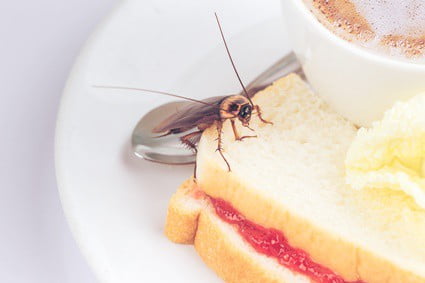
Where Do Cockroaches Bite?
Roaches usually bite the extremities, especially if they carry the scent of food. You’re more likely to get bitten by a cockroach on your:
- Lower arms
- Lower legs
- Hands
- Feet
They have also been known to bite or eat fingernails, hair, eyelashes, and calloused skin.
Are Cockroach Bites Harmful?
Cockroaches are not toxic or venomous. The bite itself won’t cause you any lasting harm. It will just be annoying, much like a mosquito bite. However, roaches carry bacteria and germs. What should you do if a cockroach bites you?
- Wash the area with soap and water
- Keep the area clean and exposed to air
- Don’t bandage it, and avoid tight clothing on the area
The chances are that the bite mark and redness will start to subside in a matter of hours, without any lasting effects.
How To Prevent Cockroach Bites
Cockroaches are attracted to the smell of rot and decay, as well as food. If you want to avoid getting bitten, you need to deter the cockroaches themselves. This can be done in the following ways:
- Remove human smell. Before bed, wash your hands and face
- Remove traces of food. Avoid eating in your bed and your bedroom as a whole.
- Keep your bedroom clean. Roaches may hide in these areas and come out for the nearest food source.
Roaches don’t have teeth as we understand them. They do, instead, have a complex way of consuming food and biting. The best way to avoid an encounter with cockroaches is to deter them from your food sources.
